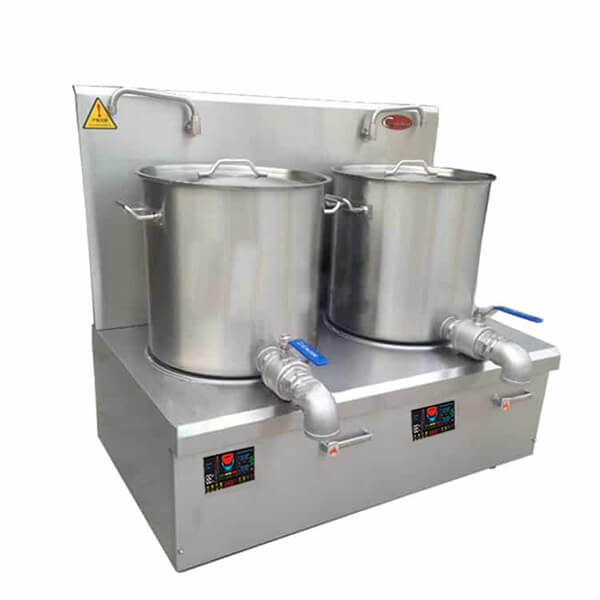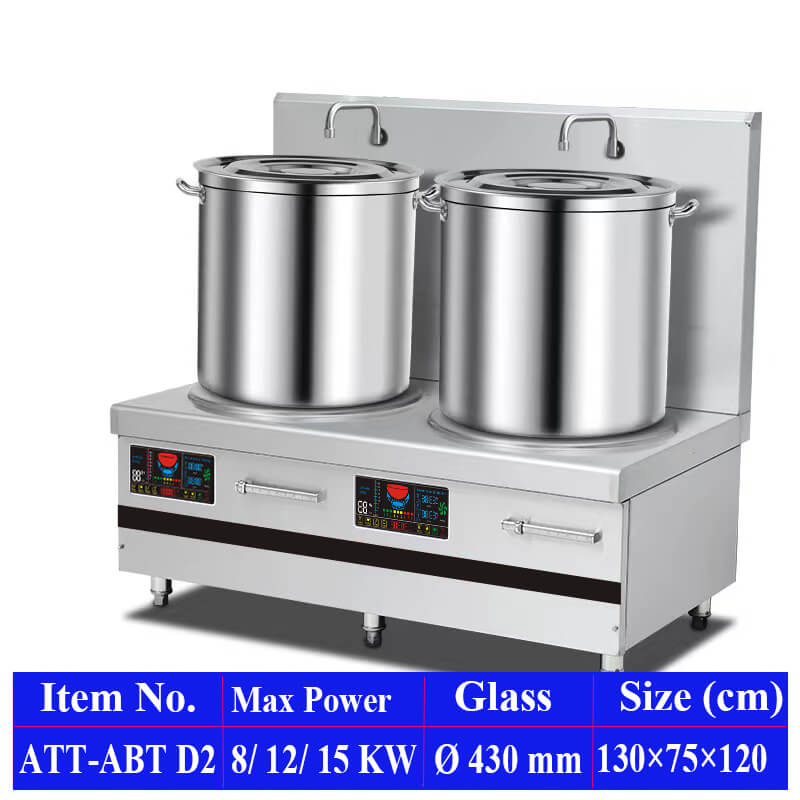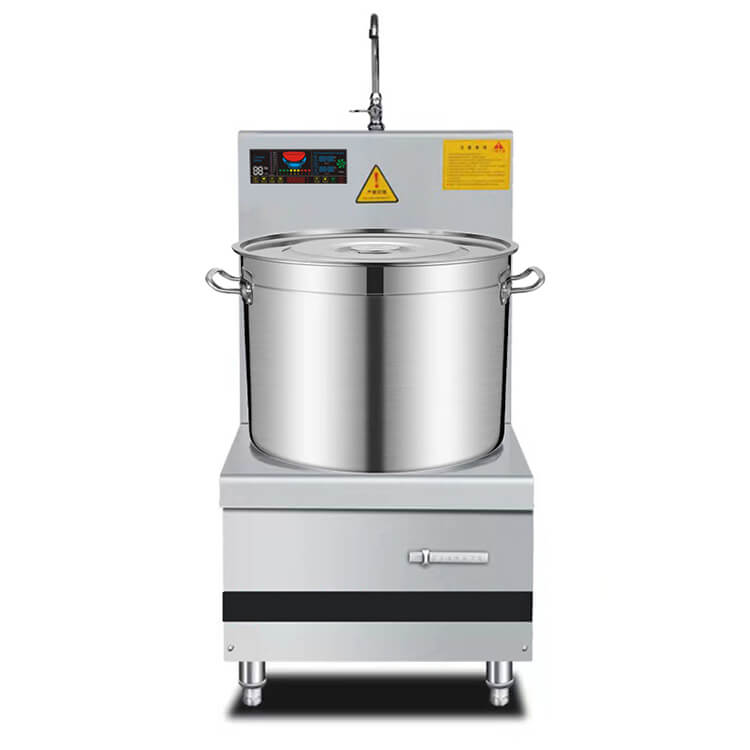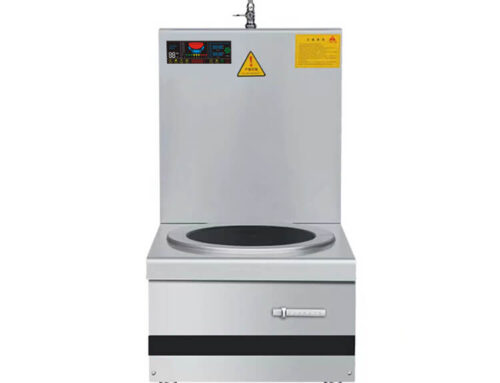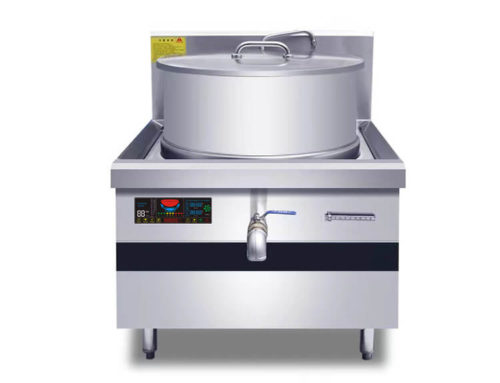Soup Cooker Materials: How They Impact Durability & Heat Retention
For commercial kitchens—from restaurants to hotels and catering services—a reliable soup cooker is essential for preparing large batches of soups, stocks, and stews. The choice of material in a soup cooker directly affects two critical factors: durability (how well it withstands daily commercial use) and heat retention (how long it keeps food hot while minimizing energy waste). At Cooker, with 15 years of experience understanding commercial kitchen pain points, we’ve tested and refined our soup kettle designs to prioritize materials that balance longevity, performance, and cost-effectiveness. This guide explores the most common materials used in commercial soup cookers, their impact on durability and heat retention, and why AT Cooker’s material choices stand out for busy kitchen environments. Whether you’re investing in an electric soup pot or a restaurant-grade kettle soup pot, understanding materials will help you make a decision that reduces operational costs and improves efficiency.
1. Stainless Steel: The Gold Standard for Commercial Soup Cookers
Stainless steel is the most widely used material in commercial soup cooker construction—and for good reason. Its unique combination of durability, corrosion resistance, and versatility makes it ideal for the rigors of daily commercial use. At Cooker’s commercial soup kettles (including our 98L, 196L, and 400L models) feature 304# stainless steel, which is recognized as the premium grade for food service equipment.
304 stainless steel contains high levels of chromium (18%) and nickel (8%), which form a protective oxide layer on the surface. This layer resists rust, corrosion, and staining—even when exposed to acidic soups, salty broths, and frequent cleaning with commercial detergents. For commercial kitchens that use soup cookers 8+ hours a day, this corrosion resistance translates to a longer lifespan: our stainless steel soup kettles typically last 8-10 years, compared to 3-5 years for lower-grade materials.
In terms of heat retention, stainless steel performs admirably when paired with induction heating. Our soup cookers leverage 90%-95% energy-efficient induction technology, which heats the stainless steel pot directly rather than wasting heat on the surrounding air. The heavy-gauge (2.5mm) stainless steel body of our kettles retains heat effectively, keeping soups hot for hours without constant reheating. This not only saves energy but also ensures food safety by maintaining safe serving temperatures.
Chinese commercial kitchen operators consistently rank stainless steel as their top choice for soup cookers, citing its easy cleaning and hygienic properties. The smooth surface of 304 stainless steel prevents food buildup, and it’s compatible with commercial sanitizers—critical for meeting food safety regulations. Our 5-year warranty for all commercial cooking equipment covers our stainless steel construction, reflecting our confidence in its durability.
2. Aluminum: Lightweight with Excellent Heat Conductivity
Aluminum is another common material in soup kettles, prized for its exceptional heat conductivity. It heats up faster and distributes heat more evenly than most other materials, making it ideal for soups that require precise temperature control. However, aluminum has tradeoffs that make it less suitable for heavy commercial use compared to stainless steel.
Pure aluminum is soft and prone to dents, scratches, and warping—issues that can shorten the lifespan of a soup cooker in a busy kitchen. It’s also reactive with acidic foods (like tomato-based soups or citrus-infused broths), which can cause the metal to leach into the food, altering its flavor and color. For these reasons, most commercial aluminum soup kettles are either anodized (coated with a protective layer) or lined with stainless steel to prevent reactivity and damage.
In terms of heat retention, aluminum falls short of stainless steel and cast iron. It heats quickly but loses heat just as fast, meaning you’ll need to use more energy to maintain temperature—directly impacting operational costs. For commercial kitchens looking to reduce operational costs by 30%-70%, aluminum’s poor heat retention is a significant drawback.
At Cooker occasionally uses aluminum in specialized, lightweight soup kettles for mobile catering or small kitchens where portability is key. However, we always recommend stainless steel for high-volume, daily use—our customers report that the durability and energy savings of stainless steel far outweigh the lightweight benefit of aluminum.
AT Cooker Pro Tip
If you need a portable soup kettle for catering events, choose an anodized aluminum model with a stainless steel lining. This combination balances heat conductivity with durability, but avoid using it for acidic soups to prevent flavor alteration.
3. Cast Iron: Superior Heat Retention with Maintenance Requirements
Cast iron is legendary for its heat retention—once heated, it maintains temperature for hours, making it ideal for slow-cooked soups and stocks. It distributes heat evenly, preventing hot spots that can burn food, and its durability is unmatched when properly maintained. However, cast iron soup kettles have significant drawbacks that limit their use in modern commercial kitchens.
Cast iron is extremely heavy: a 50L cast iron soup kettle can weigh 40-50kg, making it difficult to move and clean. It also requires regular seasoning (coating with oil) to prevent rust, which adds to maintenance time and labor costs. For commercial kitchens with high turnover or limited staff, this maintenance is often impractical.
Another challenge is reactivity: cast iron reacts with acidic foods, leading to flavor changes and rust formation. While enamel-coated cast iron addresses this issue, the enamel can chip or crack with heavy use—exposing the cast iron underneath. This makes enamel-coated cast iron a risky choice for busy commercial environments where equipment is frequently moved or bumped.
At Cooker recognizes the heat retention benefits of cast iron but recommends it only for specialized applications, such as boutique restaurants that focus on artisanal soups. For most commercial kitchens, our stainless steel soup cookers offer a better balance of heat retention, durability, and low maintenance—aligning with our goal of reducing labor and operational costs.
4. Enamel-Coated Steel: Durability Meets Easy Cleaning
Enamel-coated steel soup kettles combine the durability of steel with the easy cleaning and non-reactive properties of enamel. The base material is typically carbon steel or stainless steel, coated with a layer of vitreous enamel that creates a smooth, non-porous surface. This material is popular in commercial kitchens that value hygiene and aesthetic appeal.
Enamel is non-reactive, so it won’t alter the flavor of acidic soups or stocks. It’s also resistant to stains and easy to clean—most spills wipe away with a damp cloth, reducing maintenance time. The enamel coating adds a layer of protection against corrosion, extending the lifespan of the kettle.
However, enamel-coated steel has limitations. The enamel can chip if the kettle is dropped or hit with heavy utensils, and once chipped, the underlying steel is prone to rust. It also has lower heat conductivity than aluminum or cast iron, meaning it takes longer to heat up and may require more energy. For commercial kitchens that need fast cooking times, this can be a drawback.
At Cooker offers enamel-coated steel as an option for our smaller soup kettles (98L and below), but we recommend it primarily for kitchens with lighter use. For high-volume operations, our 304 stainless steel models remain the most reliable choice—they offer similar easy cleaning benefits without the risk of chipping or reduced heat efficiency.
5. Double-Walled Stainless Steel: Enhanced Heat Retention & Energy Efficiency
Double-walled stainless steel is a premium material choice for commercial soup cookers, designed to maximize heat retention and energy efficiency. As the name suggests, it features two layers of stainless steel with a vacuum or insulated gap between them. This design minimizes heat loss, keeping soups hot for hours while reducing the need for constant reheating.
AT Cooker’s double-walled soup pot electric models are particularly popular with catering services and buffet-style restaurants. They maintain safe serving temperatures for up to 4 hours without electricity, reducing energy costs and ensuring food safety during events. The double-walled construction also makes the exterior cool to the touch, improving safety for kitchen staff and customers.
In terms of durability, double-walled stainless steel inherits all the benefits of single-walled stainless steel: corrosion resistance, scratch resistance, and long lifespan. The additional layer adds structural strength, making the kettle more resistant to dents and warping. While double-walled models have a higher upfront cost, the energy savings and extended lifespan make them a cost-effective choice for long-term use.
Chinese commercial kitchen operators report that double-walled stainless steel soup cookers reduce energy costs by an additional 15%-20% compared to single-walled models. This aligns with our commitment to reducing operational costs, making double-walled stainless steel an excellent investment for high-volume kitchens.
Soup Cooker Material Comparison: Durability & Heat Retention
| Material | Durability (Commercial Use) | Heat Retention | Maintenance Needs | Best For |
|---|---|---|---|---|
| 304 Stainless Steel | High (8-10 years) | Good (4-6 hours) | Low (wipe clean) | High-volume restaurants, hotels |
| Aluminum (Anodized) | Medium (3-5 years) | Fair (2-3 hours) | Low (avoid acidic foods) | Mobile catering, small kitchens |
| Cast Iron | High (10+ years) | Excellent (6-8 hours) | High (regular seasoning) | Boutique restaurants, slow cooking |
| Enamel-Coated Steel | Medium (4-6 years) | Fair (3-4 hours) | Low (avoid chipping) | Buffets, light commercial use |
| Double-Walled Stainless Steel | High (8-12 years) | Excellent (4-8 hours) | Low (wipe clean) | Catering, buffets, high-volume use |
6. Thermal Conductivity: How Material Affects Even Heating
Thermal conductivity (the ability to transfer heat) is a key factor in soup cooker performance. Materials with high thermal conductivity ensure even heating, preventing hot spots that can burn food or leave parts of the soup undercooked. This is particularly important for commercial kitchens that need consistent results across large batches.
Aluminum has the highest thermal conductivity of common soup cooker materials, followed by copper (rarely used in commercial kettles due to cost), cast iron, stainless steel, and enamel-coated steel. However, as discussed earlier, aluminum’s poor durability limits its use in high-volume settings.
AT Cooker addresses this tradeoff by using heavy-gauge 304 stainless steel with induction heating. While stainless steel has lower thermal conductivity than aluminum, induction heating bypasses this limitation by heating the pot directly rather than through thermal transfer. The result is even heating that rivals aluminum, with the durability and corrosion resistance of stainless steel.
Our soup cookers also feature thickened bases (3mm) to improve thermal conductivity and heat retention. This design ensures that soups heat evenly from bottom to top, eliminating hot spots and ensuring consistent flavor. Chinese users emphasize that even heating is critical for customer satisfaction—no one wants a bowl of soup that’s burning hot in one spot and lukewarm in another.
7. Durable Materials for Commercial Wear & Tear
Commercial kitchens are harsh environments: equipment is moved frequently, bumped by carts and utensils, and exposed to high temperatures and moisture. For a soup cooker to last, it must be made of materials that can withstand this wear and tear.
304 stainless steel excels in this area. Its high tensile strength resists dents and scratches, even when hit with metal ladles or dropped during cleaning. The material is also resistant to warping at high temperatures (up to 450℃ in our cookers), ensuring the kettle maintains its shape and performance over time.
AT Cooker’s soup cookers are built with heavy-gauge metals (2.5-3mm) that add structural strength. The 3-ply stainless steel housing on our larger models (196L and 400L) further enhances durability, making them suitable for use in busy hotels and catering facilities. Our 2-years free exchangeable policy covers any manufacturing defects in these materials, ensuring minimal downtime for your kitchen.
In contrast, lightweight materials like thin-gauge aluminum or enamel-coated steel are prone to dents and warping. A single drop or bump can render these kettles unusable, leading to unexpected replacement costs. For commercial kitchens looking to minimize equipment expenses, investing in durable materials like 304 stainless steel is a smart long-term decision.
8. Non-Reactive Materials: Preserving Soup Flavor
Non-reactive materials are essential for soup cookers, as reactive materials can alter the flavor, color, and nutritional value of soups and stocks. Reactive materials (like uncoated aluminum or cast iron) react with acidic ingredients (tomatoes, vinegar, citrus) and salty broths, leading to a metallic taste or discolored food.
304 stainless steel, enamel-coated steel, and glass are non-reactive materials that preserve the natural flavor of soups. AT Cooker’s focus on 304 stainless steel ensures that our soup cookers won’t react with any type of food, from acidic tomato bisque to salty beef stock. This is critical for restaurants that pride themselves on serving high-quality, flavorful soups.
Chinese culinary experts emphasize that non-reactive materials are particularly important for long-simmered stocks, which absorb flavors from the cooking vessel over time. A reactive kettle can ruin hours of work by adding unwanted metallic notes to the stock. With AT Cooker’s non-reactive soup cookers, you’ll ensure that your soups and stocks taste exactly as intended—batch after batch.
9. Insulated Exteriors: Safety & Heat Retention
Insulated exteriors are a valuable feature in commercial soup cookers, improving both safety and heat retention. The insulation (usually foam or vacuum-sealed air gaps) keeps the exterior cool to the touch, reducing the risk of burns for kitchen staff. It also minimizes heat loss, improving energy efficiency and extending the time soups stay hot.
AT Cooker’s double-walled stainless steel soup cookers feature vacuum insulation between the inner and outer layers, keeping the exterior cool even when the interior is boiling. This is particularly important in busy kitchens where staff are moving quickly and may accidentally touch the kettle.
Insulated exteriors also reduce the need for additional heating equipment, such as warming lamps. Our insulated soup cookers can keep soups hot for up to 4 hours without electricity, making them ideal for catering events or buffet lines. This not only saves energy but also reduces clutter in the kitchen.
Chinese safety regulations require commercial kitchen equipment to have cool-touch exteriors, and our insulated soup cookers exceed these standards. By choosing an insulated model, you’ll not only improve safety but also reduce energy costs and improve operational efficiency.
10. Heavy-Gauge Metals: Longevity in Restaurant Environments
The gauge (thickness) of the metal used in a soup cooker is just as important as the material itself. Heavy-gauge metals (2mm or thicker) are more durable, retain heat better, and resist warping than thin-gauge metals.
AT Cooker’s soup cookers use heavy-gauge 304 stainless steel (2.5-3mm) for the body and base. This thickness ensures that the kettle can withstand the weight of large batches of soup (up to 400L in our largest model) without bending or warping. It also improves heat retention, as thicker metal holds heat longer than thin metal.
Thin-gauge metals (1mm or less) are prone to warping at high temperatures, which can cause the kettle to sit unevenly on the cooktop and heat inconsistently. They also dent easily and have a shorter lifespan—often needing replacement within 2-3 years of commercial use.
Our 1-year free return policy reflects our confidence in the durability of our heavy-gauge construction. We stand behind our soup cookers because we know they’re built to last in even the busiest restaurant environments.
11. Material Weight: Impact on Portability & Handling
The weight of a soup cooker’s material affects its portability and handling, which is an important consideration for commercial kitchens. Heavy materials like cast iron and thick-gauge stainless steel are durable but difficult to move, while lightweight materials like aluminum are easy to transport but less durable.
AT Cooker balances durability and portability by offering a range of soup cookers with different material weights. Our small models (98L) use 2.5mm stainless steel, weighing approximately 25kg—light enough to be moved by two staff members. Our larger models (196L and 400L) feature 3mm stainless steel with built-in wheels, making them easy to move around the kitchen without compromising durability.
For mobile catering or kitchens with limited space, we offer lightweight anodized aluminum models that weigh 15-20kg for 98L capacity. These are easy to load into catering vans and store when not in use, but we always recommend using them with care to avoid dents and damage.
Chinese commercial kitchen operators report that material weight is a key factor in staff satisfaction. Heavy kettles that are difficult to move can lead to fatigue and injuries, while lightweight kettles that are too fragile can lead to frustration. AT Cooker’s range of materials and weights ensures that you can find a soup cooker that meets your kitchen’s specific needs.
12. Corrosion Resistance: Extending Electric Soup Kettle Lifespan
Corrosion is a major cause of soup cooker failure, especially in electric models where water and electricity come into close contact. Materials that resist corrosion extend the lifespan of the kettle and reduce the risk of electrical hazards.
304 stainless steel is highly corrosion-resistant, making it ideal for electric soup kettles. It resists rust and degradation even when exposed to water, steam, and cleaning chemicals. AT Cooker’s electric soup pots feature 304 stainless steel tanks, heating elements, and control panels, ensuring that all components are protected from corrosion.
Aluminum and cast iron are more prone to corrosion, especially if scratched or chipped. This can lead to rust formation, which not only damages the kettle but also contaminates food. For electric models, corrosion can cause short circuits or heating element failure—creating safety risks and costly repairs.
Our global stock availability ensures that you can get replacement parts quickly if needed, but our corrosion-resistant materials minimize the need for repairs. With AT Cooker’s electric soup kettles, you’ll enjoy a long lifespan and reliable performance—backed by our 5-year warranty.
Key Material Benefits for Commercial Soup Cookers
- 304 Stainless Steel: Corrosion-resistant, durable, non-reactive
- Double-Walled Construction: Enhanced heat retention, energy-efficient
- Heavy-Gauge Metal: Resists warping, improves heat distribution
- Insulated Exteriors: Cool-touch safety, reduced heat loss
- Non-Reactive Surfaces: Preserves food flavor, meets hygiene standards
Material-Related Cost Savings
- Durable materials reduce replacement costs (8-10 year lifespan)
- Heat-retentive materials lower energy bills (30%-70% savings)
- Low-maintenance materials reduce labor costs
- Corrosion-resistant materials minimize repair expenses
- Non-reactive materials reduce food waste from flavor alteration
13. Easy-to-Clean Materials: Improving Hygiene & Efficiency
Easy-to-clean materials are essential for commercial soup cookers, as they reduce maintenance time, improve hygiene, and ensure compliance with food safety regulations. Materials with smooth, non-porous surfaces are the easiest to clean, as they prevent food buildup and bacterial growth.
304 stainless steel and enamel-coated steel are the easiest materials to clean. Their smooth surfaces allow food spills to be wiped away with a damp cloth and commercial detergent, no scrubbing required. AT Cooker’s soup cookers feature rounded edges and seamless construction, eliminating hard-to-reach areas where food can accumulate.
Cast iron is the most difficult material to clean, as it requires careful seasoning and cannot be washed with soap (which removes the seasoning layer). Aluminum is easy to clean but prone to scratching, which creates crevices for food and bacteria to hide.
Chinese food safety regulations require commercial kitchen equipment to be cleaned and sanitized after each use, and easy-to-clean materials make this process faster and more effective. Our soup cookers’ materials reduce cleaning time by 50% compared to cast iron or aluminum models, allowing your staff to focus on serving customers rather than scrubbing equipment.
AT Cooker’s Recommendations for Soup Cooker Materials
After 15 years of serving commercial kitchens worldwide, AT Cooker has developed clear recommendations for soup cooker materials based on your specific needs. Our goal is to help you choose a material that balances durability, heat retention, and cost-effectiveness—delivering long-term value for your kitchen.
- High-Volume Restaurants & Hotels: Choose 304 stainless steel or double-walled stainless steel. These materials offer the best balance of durability, heat retention, and easy cleaning, reducing operational costs by 30%-70%.
- Mobile Catering & Small Kitchens: Opt for anodized aluminum with a stainless steel lining. This combination is lightweight and portable, with sufficient durability for occasional use.
- Boutique Restaurants & Artisanal Cooking: Consider enamel-coated cast iron for slow-cooked soups and stocks. The superior heat retention delivers exceptional flavor, but be prepared for regular maintenance.
- Buffets & Catering Events: Select double-walled stainless steel for insulated heat retention. These models keep soups hot for hours without electricity, improving food safety and reducing energy costs.
At Cooker’s soup cookers are designed with these recommendations in mind, offering a range of materials to meet every commercial kitchen’s needs. Our 304 stainless steel models remain the most popular choice, trusted by thousands of restaurants and hotels for their durability, performance, and cost savings. Backed by our 5-year warranty, 2-year free exchangeable policy, and 1-year free return guarantee, you can invest in our soup cookers with confidence.
We also maintain stock in the US, Germany, France, UK, Belgium, Italy, Spain, and Bulgaria, ensuring that you can get your soup cooker quickly and access replacement parts if needed. Our global support team is available 24/7 to answer any questions about materials, maintenance, or performance.
The material of your soup cooker is a critical investment that impacts durability, heat retention, flavor, and cost. By choosing the right material for your kitchen’s needs, you’ll reduce operational costs, improve efficiency, and serve better-tasting soups. At Cooker’s expertise in commercial kitchen materials ensures that our soup cookers are built to last, perform reliably, and deliver value for years to come.
If you’re ready to invest in a commercial soup cooker that meets your material needs, contact our team today. We’ll help you choose the right model, provide a custom quote, and answer any questions you may have. With AT Cooker, you’ll get a soup cooker that’s designed for your kitchen’s unique challenges—built with the best materials for durability and performance.
